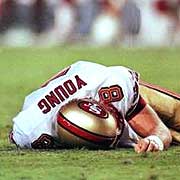
In summer 2007, TOL reported on a long-simmering problem threatening to engulf the National Football League. This issue revolved around the declining mental health status of former players who’d suffered multiple concussions or related injuries during their careers. It came to a head in the case of a 34-year old former linebacker who’d already begun to experience symptoms of extreme early-onset Alzheimer’s. He suffered multiple concussions during his brief career, but the most scandalous element of the story was the fact that his coach often put him back on the field immediately after these incidents despite medical warnings to the contrary. Another flurry of studies will, hopefully, attract a greater degree of public attention to this very real problem.
The first study involved analyzing the brains of six recently deceased former pro footballers, aged 25 to 50, all of whom had suffered from multiple concussions during their pro years. Its conclusions were universal: the cognitive functions of all six individuals were severely compromised at the time of death. While researchers have found that those with only one or two concussions often operate at near-full capacity before developing early dementia-like symptoms, these six were very significantly impaired and their brains displayed evidence of physical degeneration. All had major cognitive and behavioral problems after ending their football careers, and most had experienced depression, drug abuse/overdose or suicide. The cause of these disorders was clearly the damage their brains experienced during on-field collisions.
A separate study released in order to coincide with Super Bowl Sunday made that point even clearer by displaying more evidence of severely damaged brains. The focus of the study was the brain of 45-year old 9-year NFL veteran Tom McHale, who died of a drug overdose in 2008. After completing his autopsy, researchers concluded that he had suffered from a disease called chronic traumatic encephalopathy that involves the rapid degeneration of the brain and produces side effects ranging from memory problems to severe depression. Even more shocking was the examination of an 18-year old high school footballer who died after suffering multiple concussions. His brain exhibited signs of the very same condition, and he was the youngest subject in which it has been observed.
Another, as-yet-unpublished study spread the focus to include hockey players. It compared 19 former college athletes who played contact sports like hockey or football and had suffered from 1 to 5 concussions during their collegiate careers to a carefully-selected group of concussion-free athletes. In later adulthood, every single affected subject showed at least minor cognitive and motor-skill deficits that were not present in the concussion-free group. The conclusion should be obvious: unless we tighten regulations to prevent more concussions, this tragic pattern will repeat itself in every new generation of contact sport athletes. And the symptoms, while chronic, may not be apparent to those who’ve recently suffered concussions. Treatment must be mandatory and immediate.
The NFL, for one, has not completely ignored the problem. They actually have a “concussion committee,” and they have instituted a plan designed to provide support for retired players with neurological problems stemming from their pro years. But for an industry that brings in untold sums of money each year on merchandising alone, these moves continue to look like half-hearted gestures. The NFL and other regulatory organizations must tighten the rules of their respective games in order to better protect the mental and physical well-being of the players, no matter what their age. These should apply to amateurs and professionals alike. The issue is particularly relevant as the health problems experienced by these athletes bear many striking resemblances to those experienced by soldiers who return from our current overseas conflicts suffering from traumatic brain injury. And the conclusion is that these organizations, whether they oversee professional sports, high school sports or the American military, need to take the necessary steps to protect those who labor under them. There’s no other choice.
